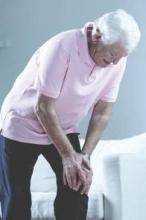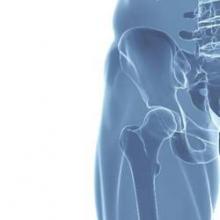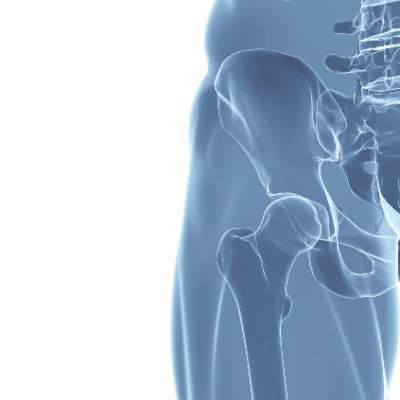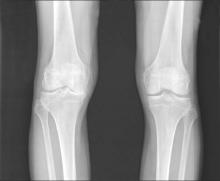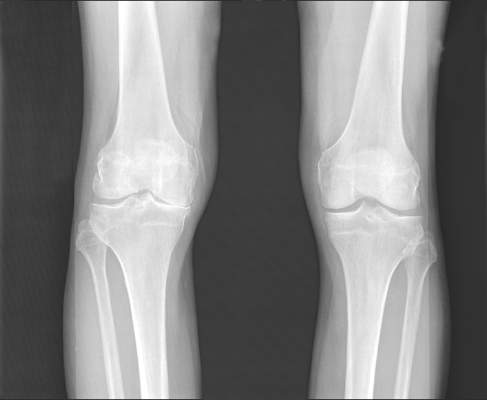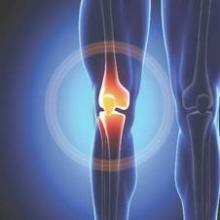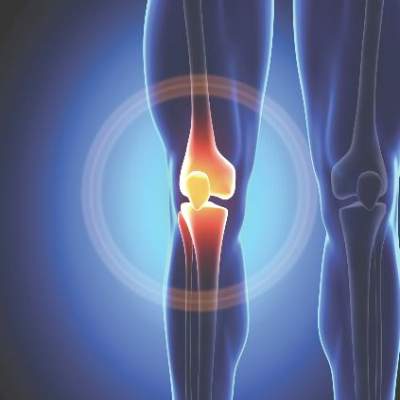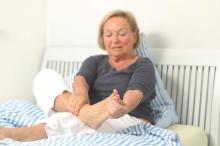User login
For MD-IQ on Family Practice News, but a regular topic for Rheumatology News
Muscle power tops strength for knee OA assessment
Leg extensor muscle power is an independent determinant of pain and quality of life in knee osteoarthritis, according to a cross-sectional analysis of data from a trial.
“Compared to strength, muscle power may be a more clinically important measure of muscle function within this population. New trials to systematically examine the impact of muscle power training interventions on disease severity in knee OA are particularly warranted,” concluded the investigators, led by Kieran Reid, Ph.D., of Tufts University in Boston (Arthritis Rheumatol. 2015 Aug 28. doi: 10.1002/art.39336).
The conclusion comes from their analysis of baseline data for 190 subjects participating in a trial comparing Tai Chi to standard physical therapy for knee OA. Their mean age was 60 years, and they had a mean body mass index of 32.7 kg/m2. The majority of participants were women.
On univariate analysis, greater muscle power – defined as the product of dynamic muscular force and muscle contraction velocity – was significantly associated with pain (r = –0.17, P less than .02), as assessed by the Western Ontario and McMaster Osteoarthritis Index. It was also significantly and positively associated with Short Form 36 physical component scores (r = 0.16, P less than .05), a measure of health-related quality of life.
After adjusting for multiple covariates, muscle power was a significant independent predictor of pain (P less than or equal to .05) and physical component scores (P less than or equal to .04). Strength, a far more common assessment in knee OA, was not an independent determinant of either pain or quality of life (P greater than or equal to .06).
To measure leg extension muscle power, subjects were asked to do two sets of five bilateral leg press repetitions, one set at 40% of their maximum strength and one set at 70%. Each repetition within a set was performed as quickly as possible, with 30 seconds rest between each repetition.
Knee OA patients “have substantial and accelerated impairments in muscle power,” and might benefit from training to improve it. Power generated at 70% resistance in the study seemed to be “a marginally greater determinant of pain and quality of life in knee OA” than power at 40%, suggesting that higher intensity training might be more helpful.
The investigators had several ideas about how power relates to knee pain. Power, rather than strength alone, helps keep the knee stable when in motion. Impairment could contribute to “inadequate control of tibial translation during ambulation, leading to damage, and ultimately knee pain.” Also, impairment probably limits the ability to dissipate knee joint loads, increasing “the risk of articular contact stress, which leads to pain,” they said.
“Muscle strength, the maximal force generating capacity of skeletal muscle, has been the focus of numerous investigations. However, studies examining muscle strength in the etiology of knee OA have presented inconsistent and controversial findings.” Dynamic leg extensor power “represents a more functionally relevant assessment of muscle performance and ... a more clinically important correlate of disease burden in knee OA,” they said.
The study was supported by grants from the National Institutes of Health. The investigators have no disclosures.
Leg extensor muscle power is an independent determinant of pain and quality of life in knee osteoarthritis, according to a cross-sectional analysis of data from a trial.
“Compared to strength, muscle power may be a more clinically important measure of muscle function within this population. New trials to systematically examine the impact of muscle power training interventions on disease severity in knee OA are particularly warranted,” concluded the investigators, led by Kieran Reid, Ph.D., of Tufts University in Boston (Arthritis Rheumatol. 2015 Aug 28. doi: 10.1002/art.39336).
The conclusion comes from their analysis of baseline data for 190 subjects participating in a trial comparing Tai Chi to standard physical therapy for knee OA. Their mean age was 60 years, and they had a mean body mass index of 32.7 kg/m2. The majority of participants were women.
On univariate analysis, greater muscle power – defined as the product of dynamic muscular force and muscle contraction velocity – was significantly associated with pain (r = –0.17, P less than .02), as assessed by the Western Ontario and McMaster Osteoarthritis Index. It was also significantly and positively associated with Short Form 36 physical component scores (r = 0.16, P less than .05), a measure of health-related quality of life.
After adjusting for multiple covariates, muscle power was a significant independent predictor of pain (P less than or equal to .05) and physical component scores (P less than or equal to .04). Strength, a far more common assessment in knee OA, was not an independent determinant of either pain or quality of life (P greater than or equal to .06).
To measure leg extension muscle power, subjects were asked to do two sets of five bilateral leg press repetitions, one set at 40% of their maximum strength and one set at 70%. Each repetition within a set was performed as quickly as possible, with 30 seconds rest between each repetition.
Knee OA patients “have substantial and accelerated impairments in muscle power,” and might benefit from training to improve it. Power generated at 70% resistance in the study seemed to be “a marginally greater determinant of pain and quality of life in knee OA” than power at 40%, suggesting that higher intensity training might be more helpful.
The investigators had several ideas about how power relates to knee pain. Power, rather than strength alone, helps keep the knee stable when in motion. Impairment could contribute to “inadequate control of tibial translation during ambulation, leading to damage, and ultimately knee pain.” Also, impairment probably limits the ability to dissipate knee joint loads, increasing “the risk of articular contact stress, which leads to pain,” they said.
“Muscle strength, the maximal force generating capacity of skeletal muscle, has been the focus of numerous investigations. However, studies examining muscle strength in the etiology of knee OA have presented inconsistent and controversial findings.” Dynamic leg extensor power “represents a more functionally relevant assessment of muscle performance and ... a more clinically important correlate of disease burden in knee OA,” they said.
The study was supported by grants from the National Institutes of Health. The investigators have no disclosures.
Leg extensor muscle power is an independent determinant of pain and quality of life in knee osteoarthritis, according to a cross-sectional analysis of data from a trial.
“Compared to strength, muscle power may be a more clinically important measure of muscle function within this population. New trials to systematically examine the impact of muscle power training interventions on disease severity in knee OA are particularly warranted,” concluded the investigators, led by Kieran Reid, Ph.D., of Tufts University in Boston (Arthritis Rheumatol. 2015 Aug 28. doi: 10.1002/art.39336).
The conclusion comes from their analysis of baseline data for 190 subjects participating in a trial comparing Tai Chi to standard physical therapy for knee OA. Their mean age was 60 years, and they had a mean body mass index of 32.7 kg/m2. The majority of participants were women.
On univariate analysis, greater muscle power – defined as the product of dynamic muscular force and muscle contraction velocity – was significantly associated with pain (r = –0.17, P less than .02), as assessed by the Western Ontario and McMaster Osteoarthritis Index. It was also significantly and positively associated with Short Form 36 physical component scores (r = 0.16, P less than .05), a measure of health-related quality of life.
After adjusting for multiple covariates, muscle power was a significant independent predictor of pain (P less than or equal to .05) and physical component scores (P less than or equal to .04). Strength, a far more common assessment in knee OA, was not an independent determinant of either pain or quality of life (P greater than or equal to .06).
To measure leg extension muscle power, subjects were asked to do two sets of five bilateral leg press repetitions, one set at 40% of their maximum strength and one set at 70%. Each repetition within a set was performed as quickly as possible, with 30 seconds rest between each repetition.
Knee OA patients “have substantial and accelerated impairments in muscle power,” and might benefit from training to improve it. Power generated at 70% resistance in the study seemed to be “a marginally greater determinant of pain and quality of life in knee OA” than power at 40%, suggesting that higher intensity training might be more helpful.
The investigators had several ideas about how power relates to knee pain. Power, rather than strength alone, helps keep the knee stable when in motion. Impairment could contribute to “inadequate control of tibial translation during ambulation, leading to damage, and ultimately knee pain.” Also, impairment probably limits the ability to dissipate knee joint loads, increasing “the risk of articular contact stress, which leads to pain,” they said.
“Muscle strength, the maximal force generating capacity of skeletal muscle, has been the focus of numerous investigations. However, studies examining muscle strength in the etiology of knee OA have presented inconsistent and controversial findings.” Dynamic leg extensor power “represents a more functionally relevant assessment of muscle performance and ... a more clinically important correlate of disease burden in knee OA,” they said.
The study was supported by grants from the National Institutes of Health. The investigators have no disclosures.
FROM ARTHRITIS & RHEUMATOLOGY
Key clinical point: It might be time to learn how to assess muscle power in your knee OA patients.
Major finding: After adjusting for multiple covariates, muscle power was a significant independent predictor of pain (P less than or equal to .05) and physical component scores (P less than or equal to .04).
Data source: Cross-sectional analysis of 190 knee OA patients.
Disclosures: The study was supported by grants from the National Institutes of Health. The investigators have no disclosures.
VIDEO: Consistency is key to monitoring patients on opioids
ORLANDO – Take a consistent approach with all patients on opioid therapy, regardless of a patient’s perceived potential for abuse, Dr. Melissa B. Weimer advised.
“This is an area of medicine where I feel we need to apply universal precautions to all patients,” noted Dr. Weimer, assistant professor of medicine, Oregon Health and Science University, Portland. “We’re treating all patients as at some level of potential harm from this medication.”
In an interview at a meeting held by the American Pain Society and Global Academy for Medical Education, Dr. Weimer outlined a strategy that employs the same protocol to monitor therapy, even when the abuse potential is considered to be low.
Global Academy and this news organization are owned by the same company. Dr. Weimer reported no financial disclosures.
The video associated with this article is no longer available on this site. Please view all of our videos on the MDedge YouTube channel
ORLANDO – Take a consistent approach with all patients on opioid therapy, regardless of a patient’s perceived potential for abuse, Dr. Melissa B. Weimer advised.
“This is an area of medicine where I feel we need to apply universal precautions to all patients,” noted Dr. Weimer, assistant professor of medicine, Oregon Health and Science University, Portland. “We’re treating all patients as at some level of potential harm from this medication.”
In an interview at a meeting held by the American Pain Society and Global Academy for Medical Education, Dr. Weimer outlined a strategy that employs the same protocol to monitor therapy, even when the abuse potential is considered to be low.
Global Academy and this news organization are owned by the same company. Dr. Weimer reported no financial disclosures.
The video associated with this article is no longer available on this site. Please view all of our videos on the MDedge YouTube channel
ORLANDO – Take a consistent approach with all patients on opioid therapy, regardless of a patient’s perceived potential for abuse, Dr. Melissa B. Weimer advised.
“This is an area of medicine where I feel we need to apply universal precautions to all patients,” noted Dr. Weimer, assistant professor of medicine, Oregon Health and Science University, Portland. “We’re treating all patients as at some level of potential harm from this medication.”
In an interview at a meeting held by the American Pain Society and Global Academy for Medical Education, Dr. Weimer outlined a strategy that employs the same protocol to monitor therapy, even when the abuse potential is considered to be low.
Global Academy and this news organization are owned by the same company. Dr. Weimer reported no financial disclosures.
The video associated with this article is no longer available on this site. Please view all of our videos on the MDedge YouTube channel
EXPERT ANALYSIS FROM PAIN CARE FOR PRIMARY CARE
VIDEO: Use fiduciary duty to set pain medication boundaries
ORLANDO – Physicians should use the concept of fiduciary duty to set appropriate boundaries with patients taking pain medications, explained Dr. Louis Kuritzky.
Often, patients want treatments that are not in their best interests, noted Dr. Kuritzky of the department of community health and family medicine at the University of Florida, Gainesville.
In an interview at a meeting held by the American Pain Society and Global Academy for Medical Education, Dr. Kuritzky outlined how physicians can take a fiduciary duty approach to set boundaries with patients in a dispassionate manner.
Global Academy and this news organization are owned by the same company. Dr. Kuritzky reported a financial relationship with Lilly.
The video associated with this article is no longer available on this site. Please view all of our videos on the MDedge YouTube channel
ORLANDO – Physicians should use the concept of fiduciary duty to set appropriate boundaries with patients taking pain medications, explained Dr. Louis Kuritzky.
Often, patients want treatments that are not in their best interests, noted Dr. Kuritzky of the department of community health and family medicine at the University of Florida, Gainesville.
In an interview at a meeting held by the American Pain Society and Global Academy for Medical Education, Dr. Kuritzky outlined how physicians can take a fiduciary duty approach to set boundaries with patients in a dispassionate manner.
Global Academy and this news organization are owned by the same company. Dr. Kuritzky reported a financial relationship with Lilly.
The video associated with this article is no longer available on this site. Please view all of our videos on the MDedge YouTube channel
ORLANDO – Physicians should use the concept of fiduciary duty to set appropriate boundaries with patients taking pain medications, explained Dr. Louis Kuritzky.
Often, patients want treatments that are not in their best interests, noted Dr. Kuritzky of the department of community health and family medicine at the University of Florida, Gainesville.
In an interview at a meeting held by the American Pain Society and Global Academy for Medical Education, Dr. Kuritzky outlined how physicians can take a fiduciary duty approach to set boundaries with patients in a dispassionate manner.
Global Academy and this news organization are owned by the same company. Dr. Kuritzky reported a financial relationship with Lilly.
The video associated with this article is no longer available on this site. Please view all of our videos on the MDedge YouTube channel
EXPERT ANALYSIS FROM PAIN CARE FOR PRIMARY CARE
ESC: Celecoxib safety study may soothe cardio concerns
LONDON – Celecoxib was associated with very low cardiovascular event rates, and its use posed no more risk than other painkillers commonly used to treat elderly individuals with arthritic conditions but no heart disease in a large, pragmatic, family practice–based study.
Results of the Standard Care Versus Celecoxib Outcome Trial (SCOT) reported at the annual congress of the European Society of Cardiology also showed that celecoxib was no more likely than nonselective nonsteroidal anti-inflammatory drugs (nsNSAIDs) to cause ulcer-related upper gastrointestinal (GI) tract complications.
In fact, the rates of both cardiovascular and GI events were so low overall that it made the trial difficult to complete, said study investigator Dr. Tom MacDonald, professor of clinical pharmacology and pharmacoepidemiology at the University of Dundee (Scotland), which sponsored the study.
The on-treatment and intention-to-treat (ITT) cardiovascular event rates were 0.9% and 1.1% per 100 patient-years, he observed, adding that he would have expected the event rate to be around 2%-3% in the population studied. GI complication rates were even lower, with just 12 on-treatment and 15 ITT events reported during the entire follow-up period, which was a maximum of 6.3 years and mean of about 3 years.
“You may remember the brouhaha surrounding the use of rofecoxib and other [cyclo-oxygenase-2 inhibitors],” said Dr. MacDonald. Both coxibs and nsNSAIDs have been associated with adverse cardiovascular outcomes such as myocardial infarction (BMJ 2005;330:1366), and rofecoxib was voluntarily withdrawn in 2004 by its manufacturer from the U.S. market. A recent meta-analysis (Lancet 2013;382:769-79) has suggested that coxibs increase the risk of major cardiovascular events by about 37%.
The SCOT study (BMJ Open 2013;3:e002295) was designed to assess if celecoxib was better, worse, or the same as the other available NSAIDs in terms of its cardiovascular and gastrointestinal safety. It was originally set up because of a requirement by the European Medicines Agency, Dr. McDonald explained.
More than 9,400 patients aged 60 years or older with osteoarthritis or rheumatoid arthritis who were prescribed chronic NSAID therapy and had no existing cardiovascular disease were screened at 706 family practices in Scotland, England, Denmark, and the Netherlands. A total of 7,297 patients were included in the prospective study and were randomized to switch to treatment with celecoxib or to continue their current nsNSAID.
General practice records were linked to hospital and mortality databases to derive the primary composite endpoint of the first occurrence of hospitalization for nonfatal MI, nonfatal stroke, or cardiovascular death, as well as secondary endpoints such as time to first hospitalization or death from upper GI complications and all-cause mortality.
Randomized patients were about 68 years old, and about 40% of patients were male. Dr. MacDonald noted that, although there was no known existing cardiovascular disease at enrollment, the baseline characteristics showed that around 44% of patients had high blood pressure; a third of patients had high cholesterol; and 20%, 12%, and 38% were taking a statin, aspirin, or ulcer-healing treatments, respectively. The most common nsNSAIDs being used were diclofenac (38.7%) and ibuprofen (31%).
There was no significant difference between celecoxib or nsNSAIDs for any of the cardiovascular endpoints studied, with hazard ratios (HR) for the primary composite cardiovascular endpoints of 1.12 (95% confidence interval, 0.81-1.55; P = .5) while on celecoxib treatment and 1.04 (95% CI, 0.81-1.33; P = .75) in the ITT analysis. Similar results were obtained for all-cause mortality (HR, 1.2 and 0.92, respectively).
Dr. MacDonald reported that 50% of patients randomized to celecoxib and 30% randomized to continue nsNSAIDs withdrew from the study. The main reasons for stopping celecoxib were a lack of efficacy (11.2% vs. 2% for nsNSAIDs), adverse events (8.3% vs. 4.4%), patient request (6% vs. 2.3%), not tolerated (3.9% vs. 1.2%), or a serious adverse event (2.6% vs. 1.9%). There was, however, a lot of adverse publicity about the coxibs, he noted, and patients who had been happy on an nsNSAID might not have been happy with the switch.
The rates of serious cardiovascular adverse events (31.7% vs. 32.4%) or reactions (5.2% vs. 5.8%) were similar with celecoxib and nsNSAIDs, but there were significantly fewer serious GI adverse reactions with celecoxib than with nsNSAIDs (38 vs. 66; P = .007). Overall, the adverse reaction rate was 22% vs. 16.1%, respectively (P <.001).
“In the study population, nsNSAIDs and celecoxib both appeared acceptably safe,” Dr. MacDonald concluded. “In patients who get significant symptomatic relief from these medicines, the benefit/risk balance appears positive.”
Although the findings are perhaps reassuring, they are unlikely to change clinical practice, observed Dr. José López-Sendon, who was invited to comment on the study results after their presentation at the conference.
The study findings suggest that celecoxib may continue to be safe to use in patients without existing cardiac disease, noted Dr. López-Sendon of Hospital Universitario La Paz in Madrid, but he would not modify the guidelines that advise that the lowest effective dose be used for the shortest duration of time in low-risk patients.
The study was sponsored by the University of Dundee and funded by an investigator-initiated research grant from Pfizer. The university’s Medicines Monitoring Unit also holds research grants from Amgen, Menarini, and Novartis. Dr. MacDonald has consulted on the use of NSAIDs for AstraZeneca, NiCox, Novartis, and Pfizer. Dr. López-Sendon did not have any disclosures relevant to his comments.
LONDON – Celecoxib was associated with very low cardiovascular event rates, and its use posed no more risk than other painkillers commonly used to treat elderly individuals with arthritic conditions but no heart disease in a large, pragmatic, family practice–based study.
Results of the Standard Care Versus Celecoxib Outcome Trial (SCOT) reported at the annual congress of the European Society of Cardiology also showed that celecoxib was no more likely than nonselective nonsteroidal anti-inflammatory drugs (nsNSAIDs) to cause ulcer-related upper gastrointestinal (GI) tract complications.
In fact, the rates of both cardiovascular and GI events were so low overall that it made the trial difficult to complete, said study investigator Dr. Tom MacDonald, professor of clinical pharmacology and pharmacoepidemiology at the University of Dundee (Scotland), which sponsored the study.
The on-treatment and intention-to-treat (ITT) cardiovascular event rates were 0.9% and 1.1% per 100 patient-years, he observed, adding that he would have expected the event rate to be around 2%-3% in the population studied. GI complication rates were even lower, with just 12 on-treatment and 15 ITT events reported during the entire follow-up period, which was a maximum of 6.3 years and mean of about 3 years.
“You may remember the brouhaha surrounding the use of rofecoxib and other [cyclo-oxygenase-2 inhibitors],” said Dr. MacDonald. Both coxibs and nsNSAIDs have been associated with adverse cardiovascular outcomes such as myocardial infarction (BMJ 2005;330:1366), and rofecoxib was voluntarily withdrawn in 2004 by its manufacturer from the U.S. market. A recent meta-analysis (Lancet 2013;382:769-79) has suggested that coxibs increase the risk of major cardiovascular events by about 37%.
The SCOT study (BMJ Open 2013;3:e002295) was designed to assess if celecoxib was better, worse, or the same as the other available NSAIDs in terms of its cardiovascular and gastrointestinal safety. It was originally set up because of a requirement by the European Medicines Agency, Dr. McDonald explained.
More than 9,400 patients aged 60 years or older with osteoarthritis or rheumatoid arthritis who were prescribed chronic NSAID therapy and had no existing cardiovascular disease were screened at 706 family practices in Scotland, England, Denmark, and the Netherlands. A total of 7,297 patients were included in the prospective study and were randomized to switch to treatment with celecoxib or to continue their current nsNSAID.
General practice records were linked to hospital and mortality databases to derive the primary composite endpoint of the first occurrence of hospitalization for nonfatal MI, nonfatal stroke, or cardiovascular death, as well as secondary endpoints such as time to first hospitalization or death from upper GI complications and all-cause mortality.
Randomized patients were about 68 years old, and about 40% of patients were male. Dr. MacDonald noted that, although there was no known existing cardiovascular disease at enrollment, the baseline characteristics showed that around 44% of patients had high blood pressure; a third of patients had high cholesterol; and 20%, 12%, and 38% were taking a statin, aspirin, or ulcer-healing treatments, respectively. The most common nsNSAIDs being used were diclofenac (38.7%) and ibuprofen (31%).
There was no significant difference between celecoxib or nsNSAIDs for any of the cardiovascular endpoints studied, with hazard ratios (HR) for the primary composite cardiovascular endpoints of 1.12 (95% confidence interval, 0.81-1.55; P = .5) while on celecoxib treatment and 1.04 (95% CI, 0.81-1.33; P = .75) in the ITT analysis. Similar results were obtained for all-cause mortality (HR, 1.2 and 0.92, respectively).
Dr. MacDonald reported that 50% of patients randomized to celecoxib and 30% randomized to continue nsNSAIDs withdrew from the study. The main reasons for stopping celecoxib were a lack of efficacy (11.2% vs. 2% for nsNSAIDs), adverse events (8.3% vs. 4.4%), patient request (6% vs. 2.3%), not tolerated (3.9% vs. 1.2%), or a serious adverse event (2.6% vs. 1.9%). There was, however, a lot of adverse publicity about the coxibs, he noted, and patients who had been happy on an nsNSAID might not have been happy with the switch.
The rates of serious cardiovascular adverse events (31.7% vs. 32.4%) or reactions (5.2% vs. 5.8%) were similar with celecoxib and nsNSAIDs, but there were significantly fewer serious GI adverse reactions with celecoxib than with nsNSAIDs (38 vs. 66; P = .007). Overall, the adverse reaction rate was 22% vs. 16.1%, respectively (P <.001).
“In the study population, nsNSAIDs and celecoxib both appeared acceptably safe,” Dr. MacDonald concluded. “In patients who get significant symptomatic relief from these medicines, the benefit/risk balance appears positive.”
Although the findings are perhaps reassuring, they are unlikely to change clinical practice, observed Dr. José López-Sendon, who was invited to comment on the study results after their presentation at the conference.
The study findings suggest that celecoxib may continue to be safe to use in patients without existing cardiac disease, noted Dr. López-Sendon of Hospital Universitario La Paz in Madrid, but he would not modify the guidelines that advise that the lowest effective dose be used for the shortest duration of time in low-risk patients.
The study was sponsored by the University of Dundee and funded by an investigator-initiated research grant from Pfizer. The university’s Medicines Monitoring Unit also holds research grants from Amgen, Menarini, and Novartis. Dr. MacDonald has consulted on the use of NSAIDs for AstraZeneca, NiCox, Novartis, and Pfizer. Dr. López-Sendon did not have any disclosures relevant to his comments.
LONDON – Celecoxib was associated with very low cardiovascular event rates, and its use posed no more risk than other painkillers commonly used to treat elderly individuals with arthritic conditions but no heart disease in a large, pragmatic, family practice–based study.
Results of the Standard Care Versus Celecoxib Outcome Trial (SCOT) reported at the annual congress of the European Society of Cardiology also showed that celecoxib was no more likely than nonselective nonsteroidal anti-inflammatory drugs (nsNSAIDs) to cause ulcer-related upper gastrointestinal (GI) tract complications.
In fact, the rates of both cardiovascular and GI events were so low overall that it made the trial difficult to complete, said study investigator Dr. Tom MacDonald, professor of clinical pharmacology and pharmacoepidemiology at the University of Dundee (Scotland), which sponsored the study.
The on-treatment and intention-to-treat (ITT) cardiovascular event rates were 0.9% and 1.1% per 100 patient-years, he observed, adding that he would have expected the event rate to be around 2%-3% in the population studied. GI complication rates were even lower, with just 12 on-treatment and 15 ITT events reported during the entire follow-up period, which was a maximum of 6.3 years and mean of about 3 years.
“You may remember the brouhaha surrounding the use of rofecoxib and other [cyclo-oxygenase-2 inhibitors],” said Dr. MacDonald. Both coxibs and nsNSAIDs have been associated with adverse cardiovascular outcomes such as myocardial infarction (BMJ 2005;330:1366), and rofecoxib was voluntarily withdrawn in 2004 by its manufacturer from the U.S. market. A recent meta-analysis (Lancet 2013;382:769-79) has suggested that coxibs increase the risk of major cardiovascular events by about 37%.
The SCOT study (BMJ Open 2013;3:e002295) was designed to assess if celecoxib was better, worse, or the same as the other available NSAIDs in terms of its cardiovascular and gastrointestinal safety. It was originally set up because of a requirement by the European Medicines Agency, Dr. McDonald explained.
More than 9,400 patients aged 60 years or older with osteoarthritis or rheumatoid arthritis who were prescribed chronic NSAID therapy and had no existing cardiovascular disease were screened at 706 family practices in Scotland, England, Denmark, and the Netherlands. A total of 7,297 patients were included in the prospective study and were randomized to switch to treatment with celecoxib or to continue their current nsNSAID.
General practice records were linked to hospital and mortality databases to derive the primary composite endpoint of the first occurrence of hospitalization for nonfatal MI, nonfatal stroke, or cardiovascular death, as well as secondary endpoints such as time to first hospitalization or death from upper GI complications and all-cause mortality.
Randomized patients were about 68 years old, and about 40% of patients were male. Dr. MacDonald noted that, although there was no known existing cardiovascular disease at enrollment, the baseline characteristics showed that around 44% of patients had high blood pressure; a third of patients had high cholesterol; and 20%, 12%, and 38% were taking a statin, aspirin, or ulcer-healing treatments, respectively. The most common nsNSAIDs being used were diclofenac (38.7%) and ibuprofen (31%).
There was no significant difference between celecoxib or nsNSAIDs for any of the cardiovascular endpoints studied, with hazard ratios (HR) for the primary composite cardiovascular endpoints of 1.12 (95% confidence interval, 0.81-1.55; P = .5) while on celecoxib treatment and 1.04 (95% CI, 0.81-1.33; P = .75) in the ITT analysis. Similar results were obtained for all-cause mortality (HR, 1.2 and 0.92, respectively).
Dr. MacDonald reported that 50% of patients randomized to celecoxib and 30% randomized to continue nsNSAIDs withdrew from the study. The main reasons for stopping celecoxib were a lack of efficacy (11.2% vs. 2% for nsNSAIDs), adverse events (8.3% vs. 4.4%), patient request (6% vs. 2.3%), not tolerated (3.9% vs. 1.2%), or a serious adverse event (2.6% vs. 1.9%). There was, however, a lot of adverse publicity about the coxibs, he noted, and patients who had been happy on an nsNSAID might not have been happy with the switch.
The rates of serious cardiovascular adverse events (31.7% vs. 32.4%) or reactions (5.2% vs. 5.8%) were similar with celecoxib and nsNSAIDs, but there were significantly fewer serious GI adverse reactions with celecoxib than with nsNSAIDs (38 vs. 66; P = .007). Overall, the adverse reaction rate was 22% vs. 16.1%, respectively (P <.001).
“In the study population, nsNSAIDs and celecoxib both appeared acceptably safe,” Dr. MacDonald concluded. “In patients who get significant symptomatic relief from these medicines, the benefit/risk balance appears positive.”
Although the findings are perhaps reassuring, they are unlikely to change clinical practice, observed Dr. José López-Sendon, who was invited to comment on the study results after their presentation at the conference.
The study findings suggest that celecoxib may continue to be safe to use in patients without existing cardiac disease, noted Dr. López-Sendon of Hospital Universitario La Paz in Madrid, but he would not modify the guidelines that advise that the lowest effective dose be used for the shortest duration of time in low-risk patients.
The study was sponsored by the University of Dundee and funded by an investigator-initiated research grant from Pfizer. The university’s Medicines Monitoring Unit also holds research grants from Amgen, Menarini, and Novartis. Dr. MacDonald has consulted on the use of NSAIDs for AstraZeneca, NiCox, Novartis, and Pfizer. Dr. López-Sendon did not have any disclosures relevant to his comments.
AT THE ESC CONGRESS 2015
Key clinical point: Celecoxib and nonselective NSAIDs were “acceptably safe” in a population without confirmed cardiovascular disease.
Major finding: The hazard ratio for the primary composite cardiovascular endpoint with celecoxib use was 1.12 (95% confidence interval, 0.81-1.55; P = .5), compared with NSAIDs.
Data source: The Standard Care Versus Celecoxib Outcome Trial (SCOT) of more than 7,200 elderly patients with osteoarthritis or rheumatoid arthritis and no confirmed cardiovascular disease.
Disclosures: The study was sponsored by the University of Dundee and funded by an investigator-initiated research grant from Pfizer. The university’s Medicines Monitoring Unit also holds research grants from Amgen, Menarini, and Novartis. Dr. MacDonald has consulted on the use of NSAIDs for AstraZeneca, NiCox, Novartis, and Pfizer. Dr. López-Sendon did not have any disclosures relevant to his comments.
Heart attack risk rises in first month after knee, hip arthroplasty
Total knee and hip arthroplasty were associated with a significantly increased risk of myocardial infarction in the first month after surgery, but not at 6 months after surgery, a cohort study showed.
The finding challenges other studies suggesting that total knee or hip arthroplasty surgery reduces the risk of serious cardiovascular events among individuals with osteoarthritis.
Analysis of data from 13,849 British patients who underwent a total knee arthroplasty, 6,063 patients who received total hip arthroplasty, and an equal number of matched controls showed a greater than eightfold increase in the risk of myocardial infarction in the first postoperative month in the knee arthroplasty group (hazard ratio, 8.75), and a fourfold increase in risk in the hip arthroplasty group (HR, 4.33), compared with controls.
However, the hazard ratio declined to insignificance after 6 months, in contrast to the risk of venous thromboembolism – a known complication of arthroplasty – according to a paper published online in the Aug. 31 edition of Arthritis & Rheumatology.
“The major difference between the previous study and ours is that cardiovascular events occurring shortly after total joint arthroplasty were excluded from the previous study,” wrote Na Lu and his colleagues from Boston University.
The study observed 306 cases of myocardial infarction among individuals who underwent total knee arthroplasty and 128 cases in those who underwent total hip arthroplasty (Arthritis Rheumatol. 2015; August 31 [doi:10.1002/art.39246]).
The study was partly support by the National Institute of Arthritis and Musculoskeletal and Skin Diseases. There were no other conflicts of interest declared.
Total knee and hip arthroplasty were associated with a significantly increased risk of myocardial infarction in the first month after surgery, but not at 6 months after surgery, a cohort study showed.
The finding challenges other studies suggesting that total knee or hip arthroplasty surgery reduces the risk of serious cardiovascular events among individuals with osteoarthritis.
Analysis of data from 13,849 British patients who underwent a total knee arthroplasty, 6,063 patients who received total hip arthroplasty, and an equal number of matched controls showed a greater than eightfold increase in the risk of myocardial infarction in the first postoperative month in the knee arthroplasty group (hazard ratio, 8.75), and a fourfold increase in risk in the hip arthroplasty group (HR, 4.33), compared with controls.
However, the hazard ratio declined to insignificance after 6 months, in contrast to the risk of venous thromboembolism – a known complication of arthroplasty – according to a paper published online in the Aug. 31 edition of Arthritis & Rheumatology.
“The major difference between the previous study and ours is that cardiovascular events occurring shortly after total joint arthroplasty were excluded from the previous study,” wrote Na Lu and his colleagues from Boston University.
The study observed 306 cases of myocardial infarction among individuals who underwent total knee arthroplasty and 128 cases in those who underwent total hip arthroplasty (Arthritis Rheumatol. 2015; August 31 [doi:10.1002/art.39246]).
The study was partly support by the National Institute of Arthritis and Musculoskeletal and Skin Diseases. There were no other conflicts of interest declared.
Total knee and hip arthroplasty were associated with a significantly increased risk of myocardial infarction in the first month after surgery, but not at 6 months after surgery, a cohort study showed.
The finding challenges other studies suggesting that total knee or hip arthroplasty surgery reduces the risk of serious cardiovascular events among individuals with osteoarthritis.
Analysis of data from 13,849 British patients who underwent a total knee arthroplasty, 6,063 patients who received total hip arthroplasty, and an equal number of matched controls showed a greater than eightfold increase in the risk of myocardial infarction in the first postoperative month in the knee arthroplasty group (hazard ratio, 8.75), and a fourfold increase in risk in the hip arthroplasty group (HR, 4.33), compared with controls.
However, the hazard ratio declined to insignificance after 6 months, in contrast to the risk of venous thromboembolism – a known complication of arthroplasty – according to a paper published online in the Aug. 31 edition of Arthritis & Rheumatology.
“The major difference between the previous study and ours is that cardiovascular events occurring shortly after total joint arthroplasty were excluded from the previous study,” wrote Na Lu and his colleagues from Boston University.
The study observed 306 cases of myocardial infarction among individuals who underwent total knee arthroplasty and 128 cases in those who underwent total hip arthroplasty (Arthritis Rheumatol. 2015; August 31 [doi:10.1002/art.39246]).
The study was partly support by the National Institute of Arthritis and Musculoskeletal and Skin Diseases. There were no other conflicts of interest declared.
FROM ARTHRITIS & RHEUMATOLOGY
Key clinical point: Total knee and hip arthroplasty were associated with a significantly increased risk of myocardial infarction in the first month after surgery.
Major finding: Patients undergoing total knee arthroplasty have an eightfold increase in the risk of myocardial infarction in the month after surgery.
Data source: Cohort study of 13,849 total knee arthroplasty patients and 6,063 total hip arthroplasty patients and an equal number of matched controls.
Disclosures: The study was partly support by the National Institute of Arthritis and Musculoskeletal and Skin Diseases. There were no conflicts of interest declared.
Decision aids benefit OA patients considering joint replacement
Osteoarthritis patients who received patient decision aids (PtDA) in addition to usual educational resources had shorter wait times and fewer surgeries, and were more likely to reach good decision quality about joint replacement surgery, although the overall effect was not statistically significant, reported Dawn Stacey, Ph.D., of the University of Ottawa (Ont.) and her coauthors.
In a randomized, controlled trial of 343 patients undergoing orthopedic screening for hip or knee replacement surgery at an academic hospital or a community hospital, being given a PtDA (intervention) was associated with reduced wait times, compared with controls who received usual care (hazard ratio = 1.25; 95% CI, 0.99–1.60; P = .0653). Mean age of the patients was 66 years; about half had high school education or less and half had household incomes at or below the median income ($58,000) for couples aged 65 or older in Canada.
Surgery rates were 73.2% in the intervention group, compared with 80.5% in controls (relative risk = 0.91; 95% CI, 0.81-1.03), the investigators found. Good decision quality was reached by 56.1% of intervention patients and 44.5% of controls (RR = 1.25; 95% CI, 1.00–1.56, P = .050). However, the overall effect was not significant, Dr. Stacey and coauthors reported.
Most patients in the study had more severe osteoarthritis and were appropriate for considering surgery, but the PtDA may have had “greater effect and discrimination” when it was given to patients with earlier stages of osteoarthritis and may have helped them to consider their nonsurgical options, the investigators wrote.
Read the full study in Osteoarthritis and Cartilage.
Osteoarthritis patients who received patient decision aids (PtDA) in addition to usual educational resources had shorter wait times and fewer surgeries, and were more likely to reach good decision quality about joint replacement surgery, although the overall effect was not statistically significant, reported Dawn Stacey, Ph.D., of the University of Ottawa (Ont.) and her coauthors.
In a randomized, controlled trial of 343 patients undergoing orthopedic screening for hip or knee replacement surgery at an academic hospital or a community hospital, being given a PtDA (intervention) was associated with reduced wait times, compared with controls who received usual care (hazard ratio = 1.25; 95% CI, 0.99–1.60; P = .0653). Mean age of the patients was 66 years; about half had high school education or less and half had household incomes at or below the median income ($58,000) for couples aged 65 or older in Canada.
Surgery rates were 73.2% in the intervention group, compared with 80.5% in controls (relative risk = 0.91; 95% CI, 0.81-1.03), the investigators found. Good decision quality was reached by 56.1% of intervention patients and 44.5% of controls (RR = 1.25; 95% CI, 1.00–1.56, P = .050). However, the overall effect was not significant, Dr. Stacey and coauthors reported.
Most patients in the study had more severe osteoarthritis and were appropriate for considering surgery, but the PtDA may have had “greater effect and discrimination” when it was given to patients with earlier stages of osteoarthritis and may have helped them to consider their nonsurgical options, the investigators wrote.
Read the full study in Osteoarthritis and Cartilage.
Osteoarthritis patients who received patient decision aids (PtDA) in addition to usual educational resources had shorter wait times and fewer surgeries, and were more likely to reach good decision quality about joint replacement surgery, although the overall effect was not statistically significant, reported Dawn Stacey, Ph.D., of the University of Ottawa (Ont.) and her coauthors.
In a randomized, controlled trial of 343 patients undergoing orthopedic screening for hip or knee replacement surgery at an academic hospital or a community hospital, being given a PtDA (intervention) was associated with reduced wait times, compared with controls who received usual care (hazard ratio = 1.25; 95% CI, 0.99–1.60; P = .0653). Mean age of the patients was 66 years; about half had high school education or less and half had household incomes at or below the median income ($58,000) for couples aged 65 or older in Canada.
Surgery rates were 73.2% in the intervention group, compared with 80.5% in controls (relative risk = 0.91; 95% CI, 0.81-1.03), the investigators found. Good decision quality was reached by 56.1% of intervention patients and 44.5% of controls (RR = 1.25; 95% CI, 1.00–1.56, P = .050). However, the overall effect was not significant, Dr. Stacey and coauthors reported.
Most patients in the study had more severe osteoarthritis and were appropriate for considering surgery, but the PtDA may have had “greater effect and discrimination” when it was given to patients with earlier stages of osteoarthritis and may have helped them to consider their nonsurgical options, the investigators wrote.
Read the full study in Osteoarthritis and Cartilage.
Dual ACL, tibial osteotomy surgery helped knee OA patients
Gait biomechanics in patients with medial knee osteoarthritis were significantly improved 5 years after concomitant high tibial osteotomy and anterior cruciate ligament reconstruction, according to a prospective cohort study conducted by Kendal Marriott and associates.
In the 33 patients who underwent the dual surgeries, three-dimensional gait analysis showed that the peak knee adduction moment had decreased significantly in the surgical limb 5 years after surgery, compared with a nonsignificant increase in the nonsurgical limb. A significant decrease in the peak knee flexion moment was seen in both the surgical and nonsurgical limbs. Progress plateaued 2-5 years post surgery, but improvements gained were maintained at the 5-year postsurgery mark.
As concomitant high tibial osteotomy and anterior cruciate ligament reconstruction is relatively rare, “longer term follow-up and comparisons with other treatment strategies are both warranted and required to better evaluate the clinical effect of this seemingly biomechanically efficacious procedure,” the investigators concluded.
Find the full study in the American Journal of Sports Medicine (doi: 10.1177/0363546515591995).
Gait biomechanics in patients with medial knee osteoarthritis were significantly improved 5 years after concomitant high tibial osteotomy and anterior cruciate ligament reconstruction, according to a prospective cohort study conducted by Kendal Marriott and associates.
In the 33 patients who underwent the dual surgeries, three-dimensional gait analysis showed that the peak knee adduction moment had decreased significantly in the surgical limb 5 years after surgery, compared with a nonsignificant increase in the nonsurgical limb. A significant decrease in the peak knee flexion moment was seen in both the surgical and nonsurgical limbs. Progress plateaued 2-5 years post surgery, but improvements gained were maintained at the 5-year postsurgery mark.
As concomitant high tibial osteotomy and anterior cruciate ligament reconstruction is relatively rare, “longer term follow-up and comparisons with other treatment strategies are both warranted and required to better evaluate the clinical effect of this seemingly biomechanically efficacious procedure,” the investigators concluded.
Find the full study in the American Journal of Sports Medicine (doi: 10.1177/0363546515591995).
Gait biomechanics in patients with medial knee osteoarthritis were significantly improved 5 years after concomitant high tibial osteotomy and anterior cruciate ligament reconstruction, according to a prospective cohort study conducted by Kendal Marriott and associates.
In the 33 patients who underwent the dual surgeries, three-dimensional gait analysis showed that the peak knee adduction moment had decreased significantly in the surgical limb 5 years after surgery, compared with a nonsignificant increase in the nonsurgical limb. A significant decrease in the peak knee flexion moment was seen in both the surgical and nonsurgical limbs. Progress plateaued 2-5 years post surgery, but improvements gained were maintained at the 5-year postsurgery mark.
As concomitant high tibial osteotomy and anterior cruciate ligament reconstruction is relatively rare, “longer term follow-up and comparisons with other treatment strategies are both warranted and required to better evaluate the clinical effect of this seemingly biomechanically efficacious procedure,” the investigators concluded.
Find the full study in the American Journal of Sports Medicine (doi: 10.1177/0363546515591995).
Optimized analgesia, exercise cut pain in severe knee OA
A 6-week protocol of optimized analgesia followed by a 12-week exercise program significantly improved pain and functional limitations for patients with knee osteoarthritis, researchers reported in Arthritis Care and Research.
The study was the first to explore how to achieve sufficient pain relief for patients with severely painful knee OA to participate in exercise therapy, and it achieved that goal for 78% of patients, said Joyce van Tunen of the Amsterdam Rehabilitation Center and associates. “The newly developed intervention protocol was feasible, which means that patients were able to participate in exercise therapy despite their severe pain at baseline,” the researchers said. “Although the results are promising, they need to be confirmed in a randomized controlled trial.”
Guidelines recommend combining pharmacologic and nonpharmacologic modalities to improve osteoarthritis outcomes, and past studies have suggested that acetaminophen, NSAIDs, and glucosamine therapy might augment the benefits of exercise in OA, they said.
The study included 49 patients with severe knee OA whose pain scored at least 7 on a 10-point scale. Patients received standardized analgesia with acetaminophen and then were stepped up to NSAIDs, weak opioids, and intra-articular steroid injections if their pain did not improve to a 5 or lower. Patients had 2 weeks to adapt to each new prescription without further changes, and their doses were cut if they maintained pain scores of 4 or less for a month or longer. The protocol was based on the World Health Organization analgesic ladder and the Beating osteoARThritis strategy for stepped care in hip and knee OA, the investigators noted (Arthritis Care Res. 2015 Aug 3 doi: 10.1002/acr.22682).
After 6 weeks, patients continued with analgesia and started a 12-week exercise program of two 60-minute sessions per week. The first 6 weeks of the program focused on muscle strength, while the last 6 weeks aimed to maximize strength while adding functional and aerobic exercises. Patients also were asked to do physical therapy exercises at home on the days they did not take part in supervised exercise, the researchers said.
At the end of the 18-week intervention, 72% of patients reported improvement on a combined global scale, the study showed. Average pain scores improved by 30% (P < .001) and activity limitations improved by 17% (P < .001). Fully 78% of patients were able to follow the exercise program, and these patients improved their physical limitations by an extra 10% (P = .004), compared with patients who could not complete the program. Patients who were not able to finish the exercise program also had significantly worse radiographic signs of OA, compared with the others (P = .03), and tended to be younger; had higher body mass indices; and reported more pain, anxiety, and depression, the researchers said. These patients might need surgical interventions or therapy to help them learn to better cope with pain, they added.
Most of the patients had used analgesics irregularly and at suboptimal doses at baseline, in part because they feared adverse effects. However, they experienced no serious side effects from the analgesia protocol or the exercise program, the investigators noted.
The Dutch Arthritis Association funded the work. The investigators reported having no conflicts of interest.
Therapy of osteoarthritis often remains a frustration to both the patient and physician. In clinical trials as well as the clinical setting, no single nonsurgical therapeutic approach has consistently been of significant benefit.
 |
| Dr. Roy Altman |
Summaries of the medical literature are reflected by unimpressive P values, effect sizes, and other statistical methods. Yet the clinician has to use the tools available, so that several partially effective programs are often employed in the clinical setting, most often in combination – sometimes called multimodal therapy. Therapeutic guidelines are based on the literature but usually only allude to a multimodal approach.
In this study, the investigators examined a combined nonpharmacologic and pharmacologic program over an 18-week period. They easily demonstrated significant benefit of the multimodal approach. No study is perfect, and this one has multiple drawbacks, not the least of which is the lack of any control or comparison group to determine if the benefits seen are from one or both programs. Despite the drawbacks in their study design, they have contributed to filling that gap in the literature. The program of medications to reduce pain enough to increase the physical rehabilitation is logical and reflects a real-world setting.
Dr. Roy D. Altman is professor emeritus in the division of rheumatology and immunology at the University of California, Los Angeles. He reported having no relevant disclosures.
Therapy of osteoarthritis often remains a frustration to both the patient and physician. In clinical trials as well as the clinical setting, no single nonsurgical therapeutic approach has consistently been of significant benefit.
 |
| Dr. Roy Altman |
Summaries of the medical literature are reflected by unimpressive P values, effect sizes, and other statistical methods. Yet the clinician has to use the tools available, so that several partially effective programs are often employed in the clinical setting, most often in combination – sometimes called multimodal therapy. Therapeutic guidelines are based on the literature but usually only allude to a multimodal approach.
In this study, the investigators examined a combined nonpharmacologic and pharmacologic program over an 18-week period. They easily demonstrated significant benefit of the multimodal approach. No study is perfect, and this one has multiple drawbacks, not the least of which is the lack of any control or comparison group to determine if the benefits seen are from one or both programs. Despite the drawbacks in their study design, they have contributed to filling that gap in the literature. The program of medications to reduce pain enough to increase the physical rehabilitation is logical and reflects a real-world setting.
Dr. Roy D. Altman is professor emeritus in the division of rheumatology and immunology at the University of California, Los Angeles. He reported having no relevant disclosures.
Therapy of osteoarthritis often remains a frustration to both the patient and physician. In clinical trials as well as the clinical setting, no single nonsurgical therapeutic approach has consistently been of significant benefit.
 |
| Dr. Roy Altman |
Summaries of the medical literature are reflected by unimpressive P values, effect sizes, and other statistical methods. Yet the clinician has to use the tools available, so that several partially effective programs are often employed in the clinical setting, most often in combination – sometimes called multimodal therapy. Therapeutic guidelines are based on the literature but usually only allude to a multimodal approach.
In this study, the investigators examined a combined nonpharmacologic and pharmacologic program over an 18-week period. They easily demonstrated significant benefit of the multimodal approach. No study is perfect, and this one has multiple drawbacks, not the least of which is the lack of any control or comparison group to determine if the benefits seen are from one or both programs. Despite the drawbacks in their study design, they have contributed to filling that gap in the literature. The program of medications to reduce pain enough to increase the physical rehabilitation is logical and reflects a real-world setting.
Dr. Roy D. Altman is professor emeritus in the division of rheumatology and immunology at the University of California, Los Angeles. He reported having no relevant disclosures.
A 6-week protocol of optimized analgesia followed by a 12-week exercise program significantly improved pain and functional limitations for patients with knee osteoarthritis, researchers reported in Arthritis Care and Research.
The study was the first to explore how to achieve sufficient pain relief for patients with severely painful knee OA to participate in exercise therapy, and it achieved that goal for 78% of patients, said Joyce van Tunen of the Amsterdam Rehabilitation Center and associates. “The newly developed intervention protocol was feasible, which means that patients were able to participate in exercise therapy despite their severe pain at baseline,” the researchers said. “Although the results are promising, they need to be confirmed in a randomized controlled trial.”
Guidelines recommend combining pharmacologic and nonpharmacologic modalities to improve osteoarthritis outcomes, and past studies have suggested that acetaminophen, NSAIDs, and glucosamine therapy might augment the benefits of exercise in OA, they said.
The study included 49 patients with severe knee OA whose pain scored at least 7 on a 10-point scale. Patients received standardized analgesia with acetaminophen and then were stepped up to NSAIDs, weak opioids, and intra-articular steroid injections if their pain did not improve to a 5 or lower. Patients had 2 weeks to adapt to each new prescription without further changes, and their doses were cut if they maintained pain scores of 4 or less for a month or longer. The protocol was based on the World Health Organization analgesic ladder and the Beating osteoARThritis strategy for stepped care in hip and knee OA, the investigators noted (Arthritis Care Res. 2015 Aug 3 doi: 10.1002/acr.22682).
After 6 weeks, patients continued with analgesia and started a 12-week exercise program of two 60-minute sessions per week. The first 6 weeks of the program focused on muscle strength, while the last 6 weeks aimed to maximize strength while adding functional and aerobic exercises. Patients also were asked to do physical therapy exercises at home on the days they did not take part in supervised exercise, the researchers said.
At the end of the 18-week intervention, 72% of patients reported improvement on a combined global scale, the study showed. Average pain scores improved by 30% (P < .001) and activity limitations improved by 17% (P < .001). Fully 78% of patients were able to follow the exercise program, and these patients improved their physical limitations by an extra 10% (P = .004), compared with patients who could not complete the program. Patients who were not able to finish the exercise program also had significantly worse radiographic signs of OA, compared with the others (P = .03), and tended to be younger; had higher body mass indices; and reported more pain, anxiety, and depression, the researchers said. These patients might need surgical interventions or therapy to help them learn to better cope with pain, they added.
Most of the patients had used analgesics irregularly and at suboptimal doses at baseline, in part because they feared adverse effects. However, they experienced no serious side effects from the analgesia protocol or the exercise program, the investigators noted.
The Dutch Arthritis Association funded the work. The investigators reported having no conflicts of interest.
A 6-week protocol of optimized analgesia followed by a 12-week exercise program significantly improved pain and functional limitations for patients with knee osteoarthritis, researchers reported in Arthritis Care and Research.
The study was the first to explore how to achieve sufficient pain relief for patients with severely painful knee OA to participate in exercise therapy, and it achieved that goal for 78% of patients, said Joyce van Tunen of the Amsterdam Rehabilitation Center and associates. “The newly developed intervention protocol was feasible, which means that patients were able to participate in exercise therapy despite their severe pain at baseline,” the researchers said. “Although the results are promising, they need to be confirmed in a randomized controlled trial.”
Guidelines recommend combining pharmacologic and nonpharmacologic modalities to improve osteoarthritis outcomes, and past studies have suggested that acetaminophen, NSAIDs, and glucosamine therapy might augment the benefits of exercise in OA, they said.
The study included 49 patients with severe knee OA whose pain scored at least 7 on a 10-point scale. Patients received standardized analgesia with acetaminophen and then were stepped up to NSAIDs, weak opioids, and intra-articular steroid injections if their pain did not improve to a 5 or lower. Patients had 2 weeks to adapt to each new prescription without further changes, and their doses were cut if they maintained pain scores of 4 or less for a month or longer. The protocol was based on the World Health Organization analgesic ladder and the Beating osteoARThritis strategy for stepped care in hip and knee OA, the investigators noted (Arthritis Care Res. 2015 Aug 3 doi: 10.1002/acr.22682).
After 6 weeks, patients continued with analgesia and started a 12-week exercise program of two 60-minute sessions per week. The first 6 weeks of the program focused on muscle strength, while the last 6 weeks aimed to maximize strength while adding functional and aerobic exercises. Patients also were asked to do physical therapy exercises at home on the days they did not take part in supervised exercise, the researchers said.
At the end of the 18-week intervention, 72% of patients reported improvement on a combined global scale, the study showed. Average pain scores improved by 30% (P < .001) and activity limitations improved by 17% (P < .001). Fully 78% of patients were able to follow the exercise program, and these patients improved their physical limitations by an extra 10% (P = .004), compared with patients who could not complete the program. Patients who were not able to finish the exercise program also had significantly worse radiographic signs of OA, compared with the others (P = .03), and tended to be younger; had higher body mass indices; and reported more pain, anxiety, and depression, the researchers said. These patients might need surgical interventions or therapy to help them learn to better cope with pain, they added.
Most of the patients had used analgesics irregularly and at suboptimal doses at baseline, in part because they feared adverse effects. However, they experienced no serious side effects from the analgesia protocol or the exercise program, the investigators noted.
The Dutch Arthritis Association funded the work. The investigators reported having no conflicts of interest.
FROM ARTHRITIS CARE AND RESEARCH
Key clinical point: Patients with knee osteoarthritis and severe pain improved significantly with an optimized standard protocol of analgesia and exercise therapy.
Major finding: Average pain scores improved by 30% (P < .001) and activity limitations improved by 17% (P < .001).
Data source: Single-center prospective study of 49 patients with knee OA and severe pain.
Disclosures: The Dutch Arthritis Association funded the work. The investigators reported having no conflicts of interest.
New analysis suggests functional decline for most people with knee OA
Accounting for missing data revealed functional declines over time in patients with newly diagnosed knee osteoarthritis, according to researchers.
The findings contradict more optimistic results from other longitudinal studies of knee OA, said Britt Elin Øiestad, Ph.D., of Oslo and Akershus University College of Applied Sciences and her associates. “The adjusted analyses showed either stable or worsening physical function, which is more in line with what is observed in the clinic,” the investigators said.
Their analysis included data from 802 participants in either the Multicenter Osteoarthritis Study (MOST) or the Osteoarthritis Initiative (OAI) who developed symptomatic knee OA during the course of the studies.
Approximately two-thirds of affected patients were women. Patients averaged about 63-66 years of age, had average body mass index of about 30-31 kg/m2, and had not undergone total knee replacement surgery at baseline or total hip replacement at any time. The researchers used a multiple imputation method to account for missing physician visits and a local regression smoothing curve to predict clinical status just prior to total knee replacement surgery (Arthritis Care Res. 2015 Aug 3. doi: 10.1002/acr.22674). Patients in MOST who developed knee OA showed no significant change over 4 years in scores on the Western Ontario and McMaster Universities Osteoarthritis Index (WOMAC) Physical Function (pf) subscale, while their Five Times Sit to Stand Test and 20-Meter Walk Test results rose by 1.5 seconds over 5-6 years (P less than .003), the investigators said. Adjusted results from OAI were similar, revealing significant worsening over time in WOMAC-pf and 20-Meter Walk Test results. “In crude results in which we did not impute missing values or pre–total knee replacement physical function status, the trajectory of physical function was more favorable,” the researchers added. “We found that imputing missing values and predicting pre–total knee replacement function reduced some of the bias seen in the unadjusted analyses, which incorrectly suggested improvement in physical function in people with knee osteoarthritis.”
The Research Council of Norway and the National Institutes of Health funded the study. The authors did not report funding sources or conflicts of interest.
Accounting for missing data revealed functional declines over time in patients with newly diagnosed knee osteoarthritis, according to researchers.
The findings contradict more optimistic results from other longitudinal studies of knee OA, said Britt Elin Øiestad, Ph.D., of Oslo and Akershus University College of Applied Sciences and her associates. “The adjusted analyses showed either stable or worsening physical function, which is more in line with what is observed in the clinic,” the investigators said.
Their analysis included data from 802 participants in either the Multicenter Osteoarthritis Study (MOST) or the Osteoarthritis Initiative (OAI) who developed symptomatic knee OA during the course of the studies.
Approximately two-thirds of affected patients were women. Patients averaged about 63-66 years of age, had average body mass index of about 30-31 kg/m2, and had not undergone total knee replacement surgery at baseline or total hip replacement at any time. The researchers used a multiple imputation method to account for missing physician visits and a local regression smoothing curve to predict clinical status just prior to total knee replacement surgery (Arthritis Care Res. 2015 Aug 3. doi: 10.1002/acr.22674). Patients in MOST who developed knee OA showed no significant change over 4 years in scores on the Western Ontario and McMaster Universities Osteoarthritis Index (WOMAC) Physical Function (pf) subscale, while their Five Times Sit to Stand Test and 20-Meter Walk Test results rose by 1.5 seconds over 5-6 years (P less than .003), the investigators said. Adjusted results from OAI were similar, revealing significant worsening over time in WOMAC-pf and 20-Meter Walk Test results. “In crude results in which we did not impute missing values or pre–total knee replacement physical function status, the trajectory of physical function was more favorable,” the researchers added. “We found that imputing missing values and predicting pre–total knee replacement function reduced some of the bias seen in the unadjusted analyses, which incorrectly suggested improvement in physical function in people with knee osteoarthritis.”
The Research Council of Norway and the National Institutes of Health funded the study. The authors did not report funding sources or conflicts of interest.
Accounting for missing data revealed functional declines over time in patients with newly diagnosed knee osteoarthritis, according to researchers.
The findings contradict more optimistic results from other longitudinal studies of knee OA, said Britt Elin Øiestad, Ph.D., of Oslo and Akershus University College of Applied Sciences and her associates. “The adjusted analyses showed either stable or worsening physical function, which is more in line with what is observed in the clinic,” the investigators said.
Their analysis included data from 802 participants in either the Multicenter Osteoarthritis Study (MOST) or the Osteoarthritis Initiative (OAI) who developed symptomatic knee OA during the course of the studies.
Approximately two-thirds of affected patients were women. Patients averaged about 63-66 years of age, had average body mass index of about 30-31 kg/m2, and had not undergone total knee replacement surgery at baseline or total hip replacement at any time. The researchers used a multiple imputation method to account for missing physician visits and a local regression smoothing curve to predict clinical status just prior to total knee replacement surgery (Arthritis Care Res. 2015 Aug 3. doi: 10.1002/acr.22674). Patients in MOST who developed knee OA showed no significant change over 4 years in scores on the Western Ontario and McMaster Universities Osteoarthritis Index (WOMAC) Physical Function (pf) subscale, while their Five Times Sit to Stand Test and 20-Meter Walk Test results rose by 1.5 seconds over 5-6 years (P less than .003), the investigators said. Adjusted results from OAI were similar, revealing significant worsening over time in WOMAC-pf and 20-Meter Walk Test results. “In crude results in which we did not impute missing values or pre–total knee replacement physical function status, the trajectory of physical function was more favorable,” the researchers added. “We found that imputing missing values and predicting pre–total knee replacement function reduced some of the bias seen in the unadjusted analyses, which incorrectly suggested improvement in physical function in people with knee osteoarthritis.”
The Research Council of Norway and the National Institutes of Health funded the study. The authors did not report funding sources or conflicts of interest.
FROM ARTHRITIS CARE & RESEARCH
Key clinical point:A new analysis shows either stable or worsening physical function after new-onset knee osteoarthritis, contradicting more optimistic results from other longitudinal studies of knee OA.
Major finding: In adjusted analyses, patients showed stable to significantly worse results over time in WOMAC-pf, Five Times Sit to Stand, and the 20-Meter Walk Test. Crude data suggested a more positive trajectory.
Data source: Longitudinal analysis of 802 patients in the Multicenter Osteoarthritis Study or the Osteoarthritis Initiative.
Disclosures: The Research Council of Norway and the National Institutes of Health funded the study. The authors did not report funding sources or conflicts of interest.
Study reveals distinct forms of foot osteoarthritis
Osteoarthritis of the foot takes one of two forms: isolated disease of the first metatarsophalangeal joint or more extensive disease of that and several other joints of the midfoot, researchers reported online in Arthritis Care & Research.
The latter, known as polyarticular foot osteoarthritis (OA), disproportionately affects women, is associated with worse pain and disability, compared with localized disease, and tends to co-occur with nodal hand OA, said Trishna Rathod of Keele University, Staffordshire, England, and her associates.
Studies of OA phenotypes have yielded targeted treatments (Ann Intern Med. 2009;150[10]:661-9andOsteoarthritis Cartilage. 2014;22[suppl S431]) for other joints, but had not yet characterized foot OA, the researchers said. Therefore, they surveyed 533 adults who reported foot pain in the prior year and scored radiographs of their first metatarsophalangeal, first and second cuneometatarsal, navicular first cuneiform, and talonavicular joints. The patients did not have psoriatic or rheumatoid arthritis and averaged 65 years of age (Arthritis Care Res. [Hoboken] 2015 Aug. 3. doi: 10.1002/acr.22677).
In all, 15% of patients had polyarticular foot OA, 22% had isolated OA of the first metatarsophalangeal joint, and 64% had no or minimal foot arthritis, the investigators reported. About 77% of patients with polyarticular disease were women, compared with approximately half of those in the other groups (P = .001). After the researchers controlled for age and sex, polyarticular disease was significantly linked to nodal hand OA (P = .04), higher body mass index (P = .002), worse scores on a 10-point foot pain scale (6 vs. 4.9 and 5.2 for the other classes; P = .02), and worse pain and disability scores on the Manchester Foot Pain and Disability Index (P = .002 and .007), they said.
“As is the case for OA at other small joint sites, particularly the hands, patterning of individual joint involvement in radiographic foot OA is polyarticular and strongly symmetrical,” the researchers concluded. “Patterns of joint involvement in radiographic foot OA have indicated a distinction between individuals with isolated [first] metatarsophalangeal joint OA and those with a more widespread form of OA ... which also includes one or both first metatarsophalangeal joints.”
The Arthritis Research UK Programme Grant and the West Midlands North CLRN supported the work. The investigators declared no competing interests.
Osteoarthritis of the foot takes one of two forms: isolated disease of the first metatarsophalangeal joint or more extensive disease of that and several other joints of the midfoot, researchers reported online in Arthritis Care & Research.
The latter, known as polyarticular foot osteoarthritis (OA), disproportionately affects women, is associated with worse pain and disability, compared with localized disease, and tends to co-occur with nodal hand OA, said Trishna Rathod of Keele University, Staffordshire, England, and her associates.
Studies of OA phenotypes have yielded targeted treatments (Ann Intern Med. 2009;150[10]:661-9andOsteoarthritis Cartilage. 2014;22[suppl S431]) for other joints, but had not yet characterized foot OA, the researchers said. Therefore, they surveyed 533 adults who reported foot pain in the prior year and scored radiographs of their first metatarsophalangeal, first and second cuneometatarsal, navicular first cuneiform, and talonavicular joints. The patients did not have psoriatic or rheumatoid arthritis and averaged 65 years of age (Arthritis Care Res. [Hoboken] 2015 Aug. 3. doi: 10.1002/acr.22677).
In all, 15% of patients had polyarticular foot OA, 22% had isolated OA of the first metatarsophalangeal joint, and 64% had no or minimal foot arthritis, the investigators reported. About 77% of patients with polyarticular disease were women, compared with approximately half of those in the other groups (P = .001). After the researchers controlled for age and sex, polyarticular disease was significantly linked to nodal hand OA (P = .04), higher body mass index (P = .002), worse scores on a 10-point foot pain scale (6 vs. 4.9 and 5.2 for the other classes; P = .02), and worse pain and disability scores on the Manchester Foot Pain and Disability Index (P = .002 and .007), they said.
“As is the case for OA at other small joint sites, particularly the hands, patterning of individual joint involvement in radiographic foot OA is polyarticular and strongly symmetrical,” the researchers concluded. “Patterns of joint involvement in radiographic foot OA have indicated a distinction between individuals with isolated [first] metatarsophalangeal joint OA and those with a more widespread form of OA ... which also includes one or both first metatarsophalangeal joints.”
The Arthritis Research UK Programme Grant and the West Midlands North CLRN supported the work. The investigators declared no competing interests.
Osteoarthritis of the foot takes one of two forms: isolated disease of the first metatarsophalangeal joint or more extensive disease of that and several other joints of the midfoot, researchers reported online in Arthritis Care & Research.
The latter, known as polyarticular foot osteoarthritis (OA), disproportionately affects women, is associated with worse pain and disability, compared with localized disease, and tends to co-occur with nodal hand OA, said Trishna Rathod of Keele University, Staffordshire, England, and her associates.
Studies of OA phenotypes have yielded targeted treatments (Ann Intern Med. 2009;150[10]:661-9andOsteoarthritis Cartilage. 2014;22[suppl S431]) for other joints, but had not yet characterized foot OA, the researchers said. Therefore, they surveyed 533 adults who reported foot pain in the prior year and scored radiographs of their first metatarsophalangeal, first and second cuneometatarsal, navicular first cuneiform, and talonavicular joints. The patients did not have psoriatic or rheumatoid arthritis and averaged 65 years of age (Arthritis Care Res. [Hoboken] 2015 Aug. 3. doi: 10.1002/acr.22677).
In all, 15% of patients had polyarticular foot OA, 22% had isolated OA of the first metatarsophalangeal joint, and 64% had no or minimal foot arthritis, the investigators reported. About 77% of patients with polyarticular disease were women, compared with approximately half of those in the other groups (P = .001). After the researchers controlled for age and sex, polyarticular disease was significantly linked to nodal hand OA (P = .04), higher body mass index (P = .002), worse scores on a 10-point foot pain scale (6 vs. 4.9 and 5.2 for the other classes; P = .02), and worse pain and disability scores on the Manchester Foot Pain and Disability Index (P = .002 and .007), they said.
“As is the case for OA at other small joint sites, particularly the hands, patterning of individual joint involvement in radiographic foot OA is polyarticular and strongly symmetrical,” the researchers concluded. “Patterns of joint involvement in radiographic foot OA have indicated a distinction between individuals with isolated [first] metatarsophalangeal joint OA and those with a more widespread form of OA ... which also includes one or both first metatarsophalangeal joints.”
The Arthritis Research UK Programme Grant and the West Midlands North CLRN supported the work. The investigators declared no competing interests.
FROM ARTHRITIS CARE & RESEARCH
Key clinical point:Osteoarthritis of the foot manifests as either isolated disease of the first metatarsophalangeal joint or as more debilitating disease of that joint and several others of the midfoot.
Major finding: Affected patients had either polyarticular foot OA or isolated OA of the first metatarsophalangeal joint, and the former was associated with significantly worse pain and functional limitations.
Data source: Prospective observational cohort study of 533 adults who reported foot pain in the previous year.
Disclosures: The Arthritis Research UK Programme Grant and the West Midlands North CLRN supported the work. The investigators declared no competing interests.
